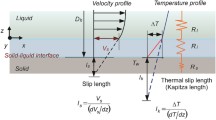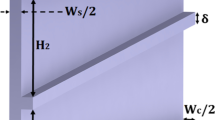Abstract
The present work is devoted to experimental investigations on the viscous heating associated with fluid flows in microchannels with non-adiabatic walls. A very simple model is proposed that demonstrate the relative influence of the thermal entrance length \(L^*\) on the temperature rise of a fluid flowing through a rectangular or trapezoidal microchannel. By resolving directly the 1D energy conservation equation, we get an explicit relation describing the evolution of the temperature along the direction of the flow. That model shows that the adiabatic solution is realistic especially when the length of the channel is much lower than \(L^*\). It also demonstrates that when reducing the hydraulic diameter \(D_h\), a steady-state thermal profile is reached and heat losses through the walls considerably limit the temperature rise. Experimental data have been recorded through hybrid silicon–Pyrex trapezoidal microchannels for a large range of hydraulic diameters (73 ≤ D h ≤ 353 μm) and aspect ratio \((0.05 \le \chi \le 0.5)\) with isopropanol and ethanol as the working fluids. The experimental data match the values expected from the model that can be useful to predict the order of magnitude of the longitudinal viscous heating in any configuration.




Similar content being viewed by others
References
Al-Arabi M (1982) Turbulent heat transfer in the entrance region of a tube. Heat Transf Eng 3:76–83
Baviere R, Ayela F, Le Person S, Favre-Marinet M (2005) Experimental characterization of water flow through smooth rectangular microchannels. Phys Fluids 17:098105
Brown G (1960) Heat or mass transfer in a fluid in laminar flow in a circular or flat conduit. AICHE J 6:179–83
Brown G, Ziegler W (1979) Temperature dependence of excess thermodynamic properties of ethanol + n-heptane and 2-propanol + n-heptane solutions. J Chem Eng Data 24:319–330
Celata P, Morini G, Marconi V, McPhail S, Zummo G (2006) Using viscous heating to determine the friction factor in microchannels—an experimental validation. Exp Therm Fluid Sci 30:725–731
Del Guidice S, Nonino C, Savino S (2007) Effects of viscous dissipation and temperature dependent viscosity in thermally and simultaneously developing laminar flows in microchannels. Int J Heat Fluid Flow 28:15–27
Guyer E (1989) Handbook of applied thermal design. McGraw-Hill, New York
Hetsroni G, Mosyak A, Pogrebnyak E, Yarin L (2005) Fluid flow in micro-channels. Int J Heat Mass Transf 48:1982–1998
Idel’cik I (1986) Mémento des pertes de charges. Eyrolles, Paris
Jones O (1976) An improvement in the calculation of turbulent friction in rectangular ducts. J Fluid Eng 98:173–180
Judy J, Maynes D, Webb B (2002) Characterization of frictional pressure drop for liquid flows through micro-channels. Int J Heat Mass Transf 45:3477–3489
Kang Y, Yang S (2013) Integrated microfluidic viscometer equipped with fluid temperature controller for measurement of viscosity in complex fluids. Microfluid Nanofluid 14:657–668
Kawashima D, Asako Y (2012) First law analysis for viscous dissipation in liquid flow in micro-channels. Int J Heat Mass Transf 55:2244–2248
Koo J, Kleinstreuer C (2004) Viscous dissipation effects in microtubes and microchannels. Int J Heat Mass Transf 47:3159–3169
Kosar A (2010) Effect of substrate thickness and material on heat transfer in microchannel heat sinks. Int J Heat Mass Transf 49:635–642
Lee P, Garimella S (2006) Thermally developing flow and heat transfer in rectangular microchannels of different aspect ratios. Int J Heat Mass Transf 49:3060–3067
Lelea D, Cioabla A (2011) The developing heat transfer and fluid flow in micro-channel heat sink with viscous heating effect. Heat Mass Transf 47:751–758
Moharana M, Singh P, Khandekar S (2012) Optimum nusselt number for simultaneously developing internal flow under conjugate conditions in a square microchannel. J Heat Transf 134:071703
Morhell N, Pastoriza H (2013) A single channel capillary microviscometer. Microfluid Nanofluid 15:475–479
Morini G (2005) Viscous heating in liquid flows in micro-channels. Int J Heat Mass Transf 48:3637–3647
Narcy M, de Malmazet E, Colin C (2014) Flow boiling in tube under normal gravity and microgravity conditions. Int J Multiph Flow 60:50–63
Qu W, Mudawar I (2002) Analysis of three-dimensional heat transfer in micro-channel heat sinks. Int J Heat Mass Transf 45:3973–3985
Renksizbulut M, Niazmand H (2006) Laminar flow and heat transfer in the entrance region of trapezoidal channels with constant wall temperature. J Heat Transf 128:63–74
Rogiers F, Baelmans M (2010) Towards maximal heat transfer rate densities for small-scale high effectiveness parallel-plate heat exchangers. Int J Heat Mass Transf 53:605–614
Shah R, London A (1971) Laminar flow forced convection heat transfer and flow friction in straight and curved ducts. Technical Report N 75, Dpt Mech Ing, Stanford University
Wibulswas P (1966) Laminar flow heat transfer in non circular ducts. PhD thesis, London University
Xu B, Ooi K, Mavriplis C, Zagloul ME (2003) Evaluation of viscous dissipation in liquid flow in microchannels. J Micromech Microeng 13:53–57
Yaws C (1999) Chemical properties handbook: physical thermodynamic environmental transport safety and health related properties for organic and inorganic chemicals. McGraw-Hill Education, New York
Ybarra R, Eckert R (1980) Viscous heat generation in slit flow. AIChE J 26:751–762
Acknowledgments
This work has been partially supported by the LabEx Tec 21 (Investissements d’Avenir-Grant agreement No ANR-11-LABX-0030). The authors acknowledge helpful assistance of the technical support of the staff of the Nanofab facilities from the Néel Institute of Grenoble. We also thank Jean-Marc Barnoud from LEGI for his help in the fabrication of the experimental set-up.
Author information
Authors and Affiliations
Corresponding author
Rights and permissions
About this article
Cite this article
Mossaz, S., Colombet, D., Ledoux, G. et al. Role of the thermal entrance length on the viscous heating in microchannels. Microfluid Nanofluid 19, 1325–1333 (2015). https://doi.org/10.1007/s10404-015-1648-3
Received:
Accepted:
Published:
Issue Date:
DOI: https://doi.org/10.1007/s10404-015-1648-3




